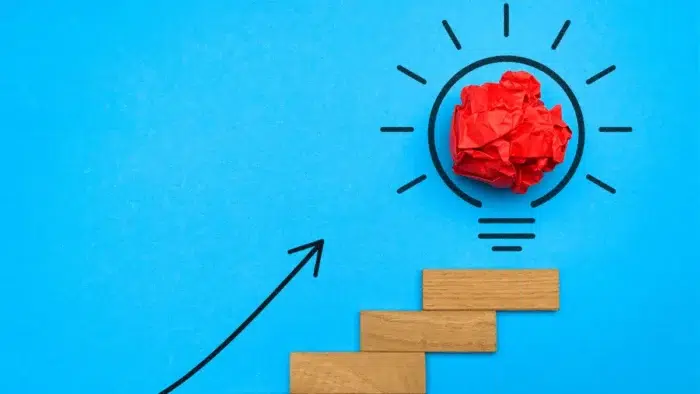Behind every successful and unsuccessful business is an entrepreneurial business idea or business ideas of potential entrepreneurs. Here, I will cover one crucial business idea generation process.
I want to note something about business ideas before we continue. They are not only for new businesses or startup companies. They can exist in the form of a photography business plan or a sophisticated strategy for boosting sales.
The new business ideas will energize every business. They will recharge a business’s potential energy, whether it is a new startup company or an existing business. Having business ideas will mean you have the ground for future business improvements. You have the vision and your dream and are ready to work on your achievements.
1. First Step of Business Idea Generation Process
How do you generate business ideas? This is a question that many enthusiastic entrepreneurs want to know the answer to. Your business ideas are the results of your entrepreneurial creativity. But, the real problem is that creativity is not always present in your entrepreneurial brain. Because of that, another question is where to start brainstorming business ideas (you can read more about 40 tips to brainstorm business ideas). What is the first step?
This question is essential to you as an entrepreneur and the basis of this business idea-generation process. Even if you know the answer to the first question and you have a bunch of ideas, they will not guarantee the success of your startup. You need to do something. So, the second question is also essential to answer. You want the brainstorming process that will give you the best results.
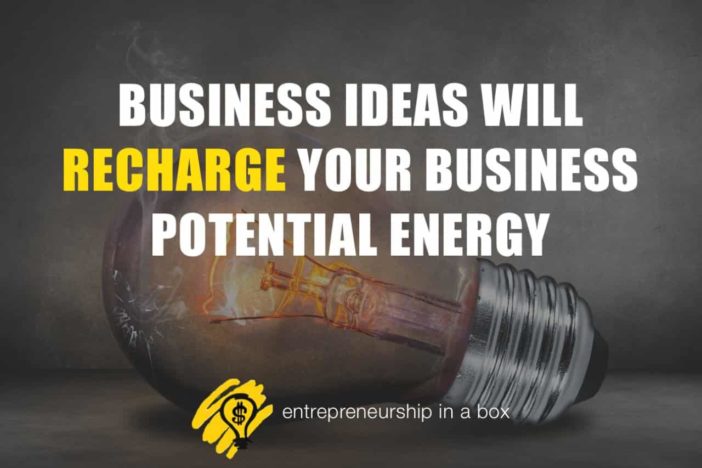
Idea Generation Techniques
There are many different idea-generation techniques you can use in your idea-generation process. Here, I will mention several of them:
The Brainstorming Ideas Process
The first step of your business ideas creation process is the brainstorming sessions. Begin with the following questions about you as a central point in your future entrepreneurial journey.
- Education – knowledge – What do you already know better than any other person on the planet?
- Hobby – What do you like to do most unrelated to your job and money-earning activities?
- Passion – What do you like to do that makes you feel delighted?
Combining the knowledge you acquired from your home culture, formal educational system, experience, free hobby activities, and passion for something may bring you excellent business ideas. You can leverage knowledge accumulated from your education to formulate new ideas for your business and apply theoretical concepts in developing these ideas.
Passion is your strong positive feeling about something you really want or something that has a strong attraction for you.
✋ Warning
So, you need to know your passions. Here is how you can find what your passion is.
If you already have a business and you need business ideas for innovative concepts or problem-solving, you can conduct brainstorming sessions to generate ideas.
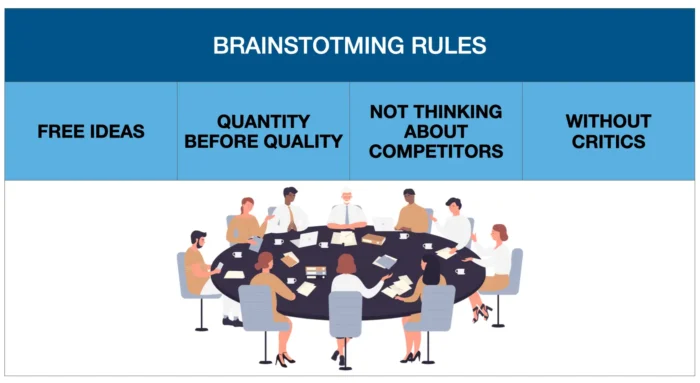
Internal and external opportunities
This idea-generation process is based on opportunities. According to where they come from, there can be internal and external opportunities.
Internal opportunities are those opportunities that come from within yourself. They can result from your knowledge, experience, skills, hobbies, or passion. It can result from your personal problem, frustration, or desire.
Most entrepreneurs start a business based on internal capabilities, but the fact is that they are not enough. This way ensures the entrepreneur’s desire to work and determination, and of course, he can succeed, but it is still not a guarantee of success.
External opportunities are those opportunities that come from outside of yourself. You can get external opportunities if you notice someone else’s need, discover a problem in the neighborhood, or follow a trend or competition. External opportunities are good because they include the key factor from the outside, which is the customer. However, they are not a sufficient guarantee of success. What if you neither know nor want to do such work?
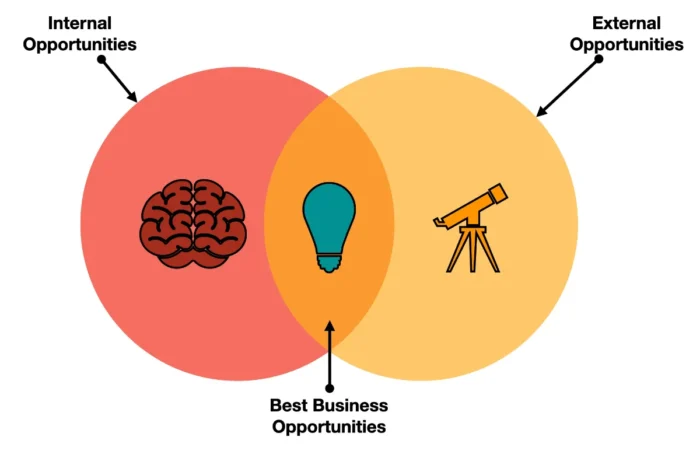
Idea challenges
You can implement idea challenges across your company based on specific questions that can be sent to specific team members or customers to collect new ideas and insides. This approach can be:
- Problem-centric idea challenge first focuses on discovering and defining the existing problem and then finding the solution to solve it.
- Solution-centric idea challenge focuses only on finding a solution for an already known problem.
As you can see, with this idea-generation technique, you can generate potential ideas for process improvements.
Innovation challenges
This technique conducts competitions or events where your company shares a specific problem or question and invites employees, customers, or the broader public to develop creative solutions. They provide an idea submissions platform for people to think outside the box and propose innovative, fresh ideas.
Opposite thinking – Reverse thinking idea generation
It is a fact that many people find themselves in familiar environments, oftentimes exploring the same concepts, solutions, and ideas in the most conventional way. To eliminate this pattern and encourage creativity, one technique can help you: reverse thinking, also known as opposite thinking.
This idea-generation technique is a creative problem-solving method that challenges conventional understanding and assumptions by taking an existing idea and asking, “What if we do the exact opposite?”
Imagine you’re running a restaurant, and conventional thinking says that you need a diverse menu to satisfy various customers’ tastes. With opposite thinking, you might ask the exact opposite, “What if we only offer one dish?” This question could lead to a unique business model, like a specialty restaurant focusing on perfecting one single dish in different variations that will target a specific niche in the market.
SCAMPER Technique for idea generation
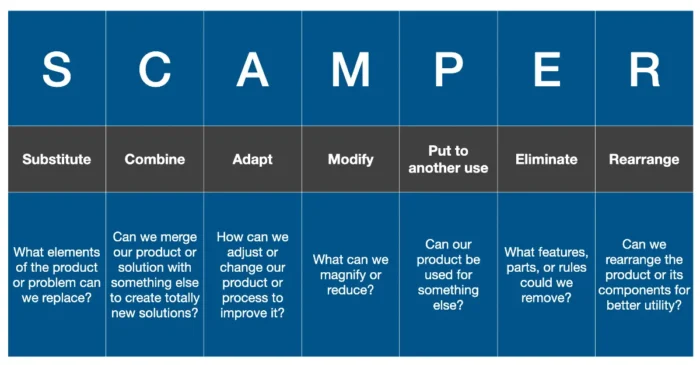
SCAMPER technique comes from an acronym where each letter prompts us to think about our subject in a new light, challenging us to reimagine all possibilities and generate more ideas quickly:
- Substitute: What elements of the product or problem can we replace?
- Combine: Can we merge our product or solution with something else to create totally new solutions?
- Adapt: How can we adjust or change our product or process to improve it?
- Modify: What can we magnify or reduce?
- Put to another use: Can our product be used for something else?
- Eliminate: What features, parts, or rules could we remove?
- Rearrange: Can we rearrange the product or its components for better utility?
5 Steps to Ensure the Success
Five steps to ensure success when you find yourself at the first step of the business idea generation process of your entrepreneurial journey are:
- Think about a possible business idea that is fun for you.
- Always have and dream big dreams.
- Trust in your business ideas.
- Find leaders in the field.
- Commit yourself to implementing your ideas.
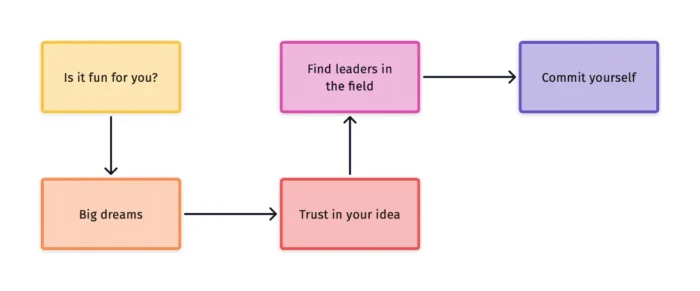
Because of that, your business must be funny. It will be fun if you have enough knowledge to implement all your business tasks, implement them as your hobby, and have a passion for that business.
You can generate ideas that are great but:
- Your business will be sentenced to death if you don’t know enough about them.
- Also, if this business is not fun for you, you will close the door very soon.
- You will not be committed enough if you don’t have a big passion or desire for what you need to work.
So, you must view every business idea at the beginning through your knowledge, hobby, and passion prism. This will help you decide what the best business idea for you is from the idea generation process.
Conclusions for First Step
- You must know the business idea you want to be part of your next business venture.
- The realization of the idea must be funny for you and look like your hobby.
- You must have a passion for that business idea.
2. Second Step in Business Idea Generation Process
When you come to a business idea that satisfies three criteria or requirements from the previous step, you can continue with the second step of the business idea generation process.
The second step is to analyze your business idea through the prism of your customers. Or, ask and answer the question: Is this business idea something that solves some critical problem on the market for my potential customers?
If you want someone to buy your products and services from your company, you must ensure that your products and services satisfy your customer’s needs. Also, it would help if you were sure they could solve those people’s problems. On the contrary, you can’t expect them to buy from you if your products and services don’t solve the customer’s problems.
For example, we want to buy a car because:
- We have a need for a means of transportation. If you only need this (transportation), you will probably buy a cheaper car to accomplish only the transportation function. It is because all cars have this primary function to satisfy customers’ needs.
- We have a need for prestige. You want to have a new beautiful car with which other people would notice you. You will use that car as a secondary means of transportation. With this need, you meet two different problems: prestige and transportation. In this case, you will buy a more expensive car that looks great and will be noticeable.
Is Your Business Idea Something That Will Satisfy Customers’ Needs?
When you think about business ideas as a part of your idea generation process, you must consider whether that product or service will satisfy your customers’ needs and how they will satisfy them.
You must create the needs you can satisfy or problems you will solve for customers. If there is no actual problem or need, the business will not exist.
The higher the needs and problems you can satisfy or solve, the higher the potential energy of that specific business idea will be.
How much the customers’ desire and “pain” for solving the problems are more significant, there will be much higher business potential energy inside those business ideas.
Conclusions Related to the Second Step of Business Ideas Development
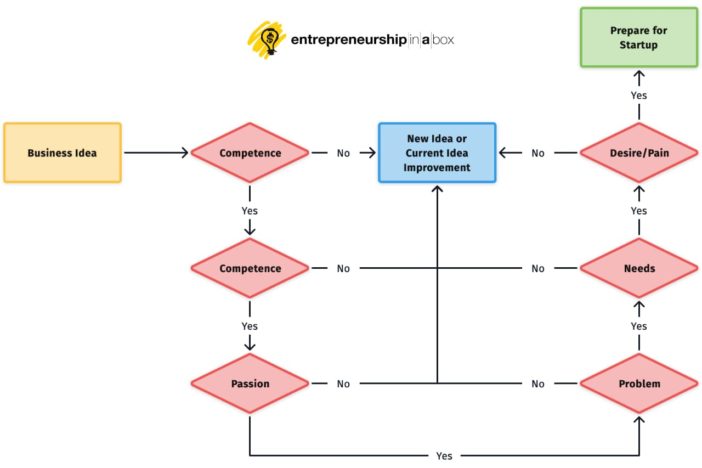
We can conclude the following:
- You must know how to implement each of your business ideas in practice.
- Implementation of your business ideas must be as funny as your hobby.
- You must have a passion for that business idea.
- The business idea must solve some problems of the customers or your target market.
- Higher needs and problems that businesses can solve will mean higher business potential energy.
- The business potential energy will also be higher because of how much bigger customers’ desires and “pains” are for solving those problems.
3. Third Step of Business Idea Generation Process: Target Market
Let’s continue with the business idea generation process that you can use to develop the business from your dreams.
At this level of your business development, thinking about the target market for that business idea will be helpful.
What is the target market?
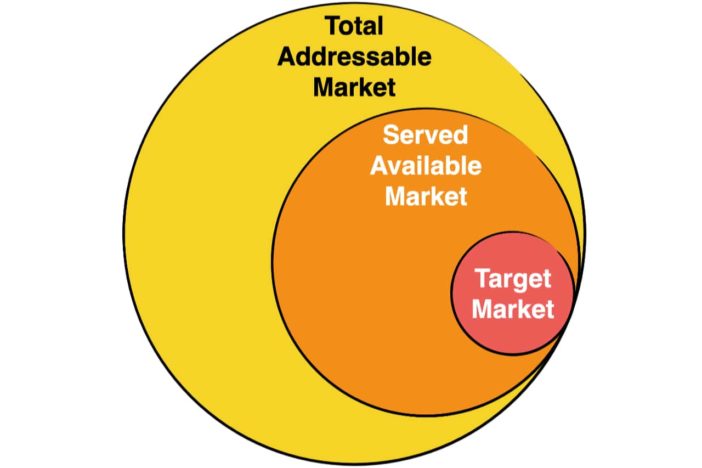
The basic idea behind including a target market in your idea generation is that a product cannot be for everyone and only on a general market. You should know your target market if you deliver a specific product or service for that specific market.
The target market is one segment of the market where your business idea will need to put the whole focus. The group of people will be a central part of all your marketing efforts.
We can say that the target market is the type of person that will want, need, or desire your product or services, but also with the highest possible purchase intent. But, defining it is the first step of establishing a niche market.
How do you identify your target market?
Identifying your targeted customers is vital for testing new business ideas and later for customizing your marketing and advertising campaigns. The goal is to generate as much revenue as possible for your products or services.
The process of identifying a target market is called market segmentation. To identify it, you must make market segmentation. You can make market segmentation when you divide your market into small parts that have the same or similar characteristics as:
- Age (for example, they will be persons between 20 to 50 years old)
- Sex (for example, they will be females)
- Geographic (for example, they are living in specific areas in specific towns)
- Revenue (for example, the target market will be a segment of the market that has revenue of more than 60.000 $)
✋ Warning
Here is how you can identify the target market for your startup with some tools you can use for this purpose.
For example, If you sell toys, your ideal or targeted customers will be mainly people with children.
It is better to use a combination of these market characteristics. For example, your target market will be [Specific town], males and females between 20 to 50 years old, with revenue above $60.000. With a statement like this, you can add problems or needs that you want to satisfy with your business idea.
This statement will help you later when you start preparing different marketing elements and sales forecasts for your business. Your sales forecast must start with your target market and selected market segment as a number. If you calculate the desire of the customer to solve the problem, leads, and competitors, you can easily forecast the sales quantity.
✋ Warning
So, now you have a business idea, but what will you need to do next?
This is a fundamental question for all entrepreneurs, especially when they are in the dreaming stage. In such a way, the whole entrepreneurial energy and force will focus on that target market. Later, you will focus your marketing activities on that specific target market. This is the basis for applying the 80/20 rule to increase entrepreneurial effectiveness and efficiency.
4. Idea Management Process
Remember that the idea-generation process is a continuous process. It is not only for startup companies but also for established companies related to product or process improvements, new product development, etc. So, you will need an idea management process to help you manage innovation inside your company.
If you already have a company, you probably already have many existing ideas ready for implementation or some next steps that need to be conducted about them. Now, with idea management, the most important questions are:
- How to manage different existing and new ideas?
- How do you ensure a continuous creative process inside your company?
- What is the priority for implementing a specific existing idea, and how do you set it?
- What idea management tools will you use?
How do You Manage Different Existing and New Ideas?
A well-structured ideation process is very important for the success of your company. It can help you improve your team’s creative thinking, generate great ideas, categorize and prioritize new ideas, and ensure that your company remains innovative and competitive.
So, the most important thing when it comes to idea management is to document all processes related to idea generation, several idea generation techniques you will use, and all the processes for the next steps your company must conduct for each of the new ideas.
How to Ensure Continuous Creative Process?
Creativity is simply connecting the dots. For Steve Jobs, creativity is all about connecting the dots. He said: “Creativity is just connecting things. When you ask a creative person how they did something, they may feel a little guilty because they didn’t really do it, they just saw something. It seemed obvious to them after awhile. That’s because they were able to connect experiences they’ve had and synthesize new things. And the reason they were able to do that was that they’ve had more experiences or have thought more about their experiences than other people have. Unfortunately, that’s too rare a commodity. A lot of people in our industry haven’t had very diverse experiences. They don’t have enough dots to connect, and they end up with very linear solutions, without a broad perspective on the problem.”
When it comes to the creative process, you must ensure that you get creative solutions and ideas from all of your team members. With appropriate processes for generating ideas and sharing them between team members, you will ensure that your company will never lack creativity and new ideas.
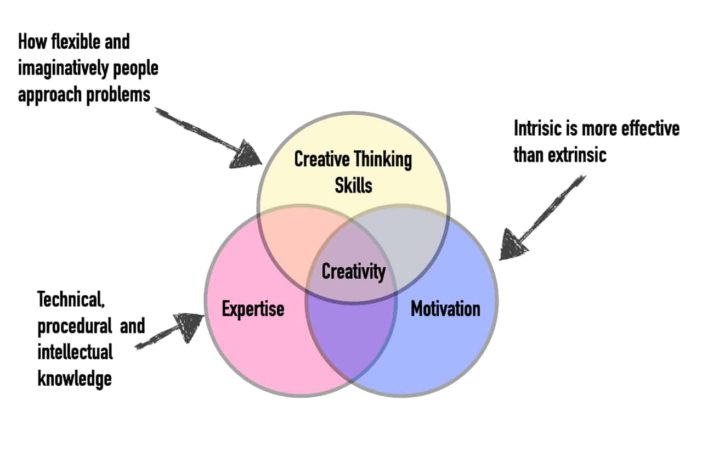
Categorization and Prioritization
Once you have a pool of ideas, the next step is to categorize them based on their relevance to your business, target audience, and also industry trends. For example, let’s conduct an idea challenge as one of many idea-generation techniques. You will collect new ideas about product development, process improvement, marketing approaches, etc. So, you must have a process that will categorize these existing ideas into categories and subcategories like:
- product ideas
- product improvement ideas
- new product development ideas
- process ideas
- process improvement ideas
- new process development ideas
- marketing ideas…
Regarding prioritization, each idea must be evaluated based on its potential impact, feasibility, and alignment with your strategic goals. So, after categorization, you must prioritize new ideas that offer the most value for your company. In this way, you will know what ideas as an output from some idea generation technique must be implemented as the highest priority. This means you will have an idea management funnel in place.
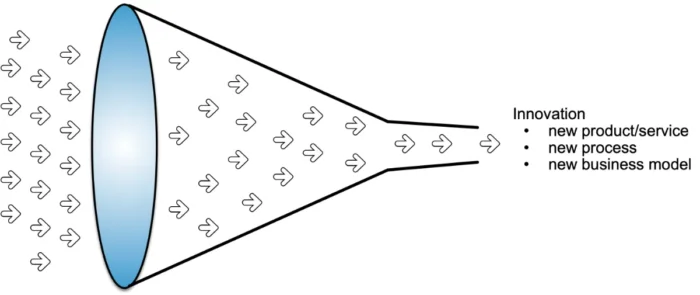
What Idea Management Tools You Will Use?
When it comes to tools, you will need to use the following:
- Idea repository. Each idea, resulting from some creative thinking process or idea generation methods, must be recorded in a specific database or business ideas book. Now, I call it a repository. This idea management tool must ensure a continuous flow of ideas, putting them in the appropriate stages of development and managing ideas through the team members’ responsibility for each stage.
- Collaboration tools. When you have a process for generating ideas, you must ensure that it covers collaboration tools to ensure all team members collaborate on generating and managing ideas inside your company.


